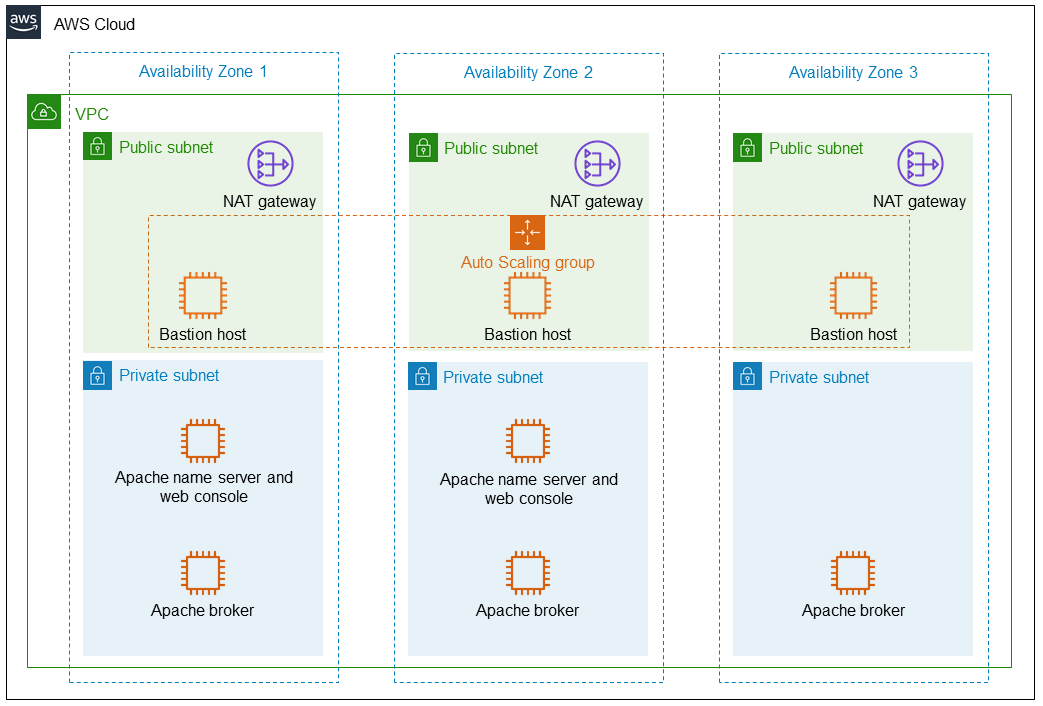reference deployment
Apache RocketMQ on AWS
Deploy Apache RocketMQ messaging queue service on the AWS Cloud
This Quick Start deploys Apache RocketMQ on the Amazon Web Services (AWS) Cloud. Apache RocketMQ is a unified messaging engine and lightweight data processing platform. This Quick Start deploys and configures Amazon Elastic Compute Cloud (Amazon EC2) instances to host a cluster of Apache name server and broker nodes. You can configure basic cluster settings such as Amazon EC2 instance types during deployment.

This Quick Start was developed by AWS.
-
What you'll build
-
How to deploy
-
Cost and licenses
-
What you'll build
-
This Quick Start sets up the following:
- A highly available architecture that spans three Availability Zones.*
- A virtual private cloud (VPC) with public and private subnets, according to AWS best practices, to provide you with your own virtual network on AWS.*
- In the public subnets:
- Managed network address translation (NAT) gateways to allow outbound internet access for resources in the private subnets.*
- Linux bastion hosts in an Auto Scaling group to allow inbound Secure Shell (SSH) access to Amazon EC2 instances in public and private subnets.*
- In the private subnets:
- Amazon EC2 instances for Apache RocketMQ name servers. You can deploy 1–3 name servers. The default is 2 (shown).
- Apache RocketMQ web console running on Apache name server instances.
- Amazon EC2 instances for Apache RocketMQ brokers. You can deploy either 1 or 3 brokers. The default is 3 (shown).
* The template that deploys the Quick Start into an existing VPC skips the components marked by asterisks and prompts you for your existing VPC configuration.
-
How to deploy
-
To deploy Apache RocketMQ, follow the instructions in the deployment guide. The deployment process takes about 15 minutes and includes these steps:
1. If you don't already have an AWS account, sign up at https://aws.amazon.com, and sign in to your account.
2. Launch the Quick Start by choosing from the following options. Before you create the stack, choose the AWS Region from the top toolbar.
3. Test the deployment.
Amazon may share user-deployment information with the AWS Partner that collaborated with AWS on this solution.
-
Cost and licenses
-
You are responsible for the cost of the AWS services and any third-party licenses used while running this Quick Start reference deployment. There is no additional cost for using the Quick Start.
The AWS CloudFormation templates for this Quick Start include configuration parameters that you can customize. Some of these settings, such as instance type, affect the cost of deployment. For cost estimates, see the pricing pages for each AWS service you use. Prices are subject to change.
Tip: After you deploy the Quick Start, create AWS Cost and Usage Reports to track costs associated with the Quick Start. These reports deliver billing metrics to an Amazon Simple Storage Service (Amazon S3) bucket in your account. They provide cost estimates based on usage throughout each month and aggregate the data at the end of the month. For more information about the report, see What are AWS Cost and Usage Reports?
